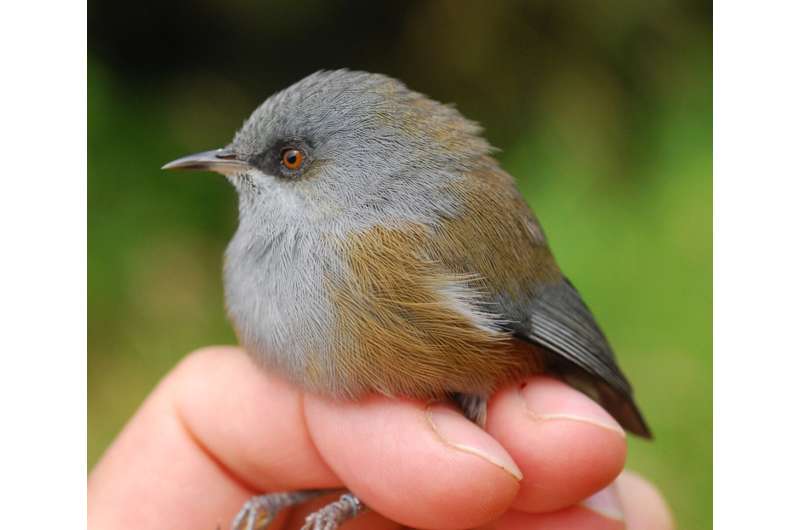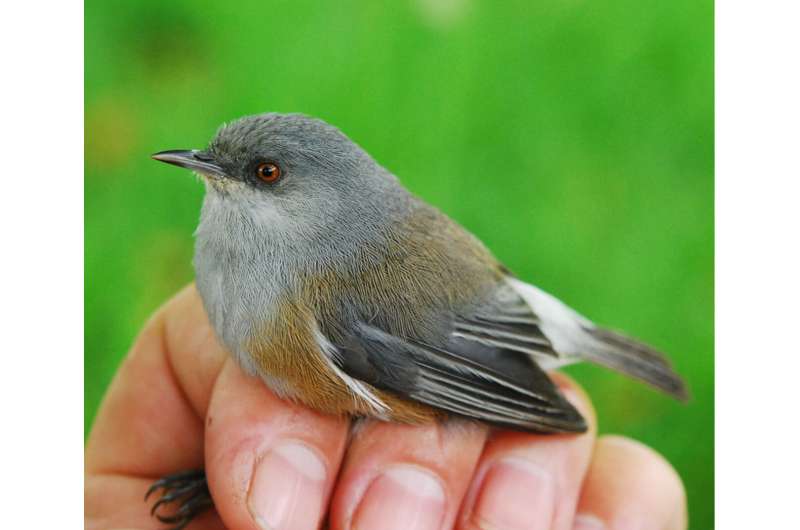Credit: Yann Bourgeois
A species of tiny bird, found on a small island has evolved into five different color variations depending on where on the island it lives.
Scientists found distinct variations in patterns of grey and brown feathers in the 10cm-long songbird, called the grey white-eye, on Reunion Island, in the Indian Ocean.
New research, led by Dr. Yann Bourgeois at the University of Portsmouth, found that natural or sexual selection have both driven differences in plumage color between territories that are only a few kilometers apart.
The study is published in Molecular Ecology.
Dr. Bourgeois said: "It surprised us that birds living just 10km apart already have differences in their DNA.
"Birds are usually seen as good dispersers, but these birds stay close to where they are born. Based on the results of this study, it's possible they may be reproducing mostly with birds of the same color."
It's also possible that hybrids—the offspring of birds from neighboring territories—might not be as successful.
Reunion Island has a huge variety of landscape, with volcanoes, rainforests and beaches, but it is also very small, at about 50km long.
The five separate grey white-eye birds' territories are bound by rivers or ancient lava flow streams, or by changes in altitude.
Dr. Bourgeois said: "These birds don't like to cross anything barren."
Credit: Yann Bourgeois
Dr. Bourgeois and colleagues sequenced the DNA of birds in each of the five color groups. They hoped to find if their regional differences were due to fitting better into their separate environments (natural selection), or because they preferred to mate with birds which looked the same as themselves (sexual selection).
The answer was both.
Natural selection has driven changes in color of birds living in the island's mountains, and sexual selection is what's keeping color variations in the lowlands.
Dr. Bourgeois said: "Sexual selection is common across many species—birds like the grey white-eye are not alone in the animal kingdom in preferring to mate with those who look the same as them.
"It's also known that big changes in altitude put a demand on all species—animals at higher altitude need more hemoglobin in their blood and tend to be bigger than their counterparts living closer to sea level, for example. It is remarkable to see adaptation in the same species to very different environments.
"We wanted to see if the regions in the genome that were associated with color traits were uniformly distributed across chromosomes or not. It appears that we observe that most of the divergence between color forms is found on the sex chromosome, and that other chromosomes seem to be involved mostly when comparing forms of high and low elevation.
"We didn't expect to find such clear color distinctions between clearly defined parts of the island, and we wanted to find out if this was due to natural or sexual selection.
"It's remarkable that both can happen in neighboring communities of birds living so close to each other.
"It opens the door to potential advances in our understanding which could help us protect and look after the natural environment."
Previous research found birds in New Zealand had developed regional accents in their songs. Dr. Bourgeois said it's highly likely the songs of each of Reunion Island's grey white-eye's five colors might also have evolved a regional accent, but research to prove it remains to be done.
More information: Yann XC Bourgeois et al. Differential divergence in autosomes and sex chromosomes is associated with intra‐island diversification at a very small spatial scale in a songbird lineage, Molecular Ecology (2020). DOI: 10.1111/mec.15396
Journal information: Molecular Ecology
Provided by University of Portsmouth

























